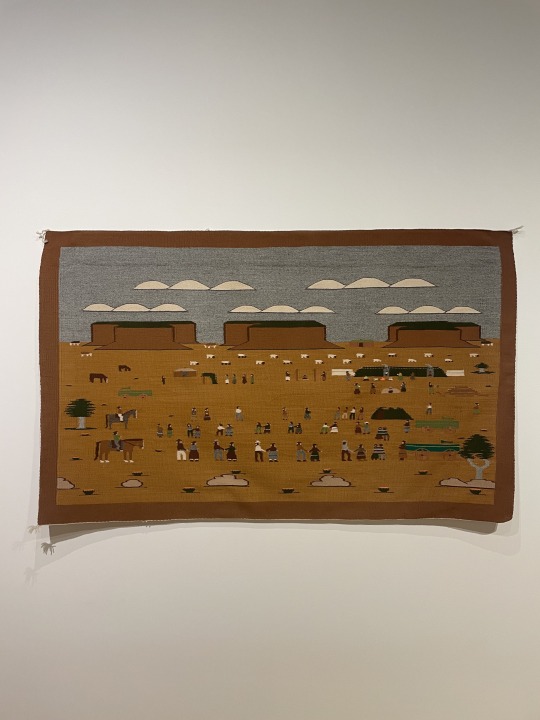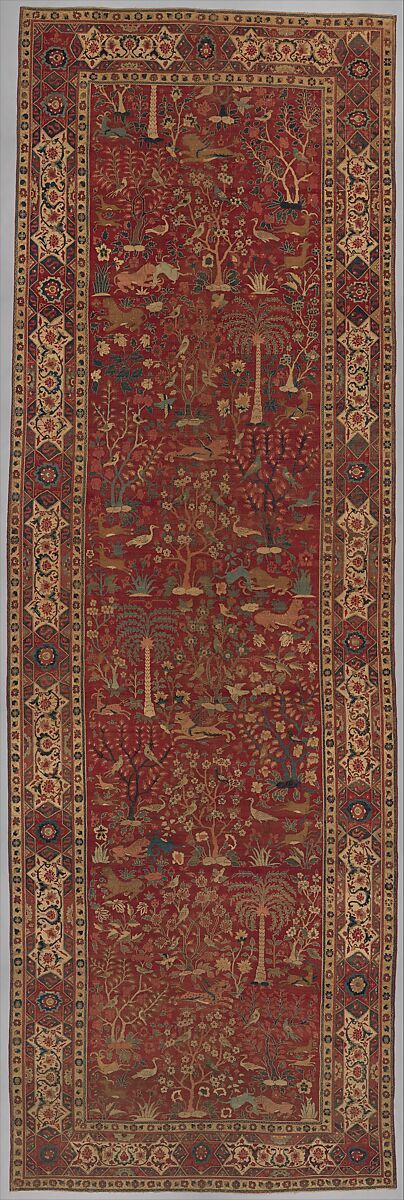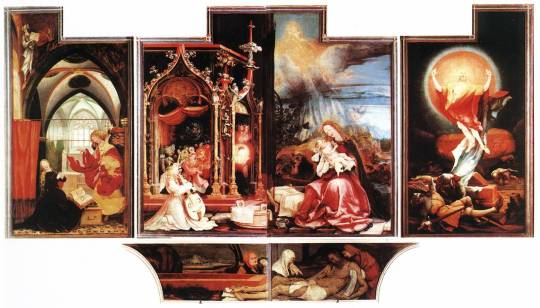#pictorial rug
Text

Here's a pictorial rug I really enjoyed by Isabel John (c. 1975).
I want to start collecting pictorial rugs this year and the next. Hit me up if you can recommend good sites for finding rugs for prices that are fair to the artist and yet which a poor author can afford
2 notes
·
View notes
Text

Hamadan pictorial rug, 1967, wool
18 notes
·
View notes
Text


Armenian pictorial rugs, early 20th c.
718 notes
·
View notes
Text

AMERICAN FOLK ART PICTORIAL HOOKED RUG, wool on burlap, striking silhouette pattern of two black horses on a blue-and-gray ground within a thin yellow border. Mounted to fabric on a wooden stretcher for hanging. Possibly Pennsylvania Mennonite. Circa 1920
Jeffrey Evans
532 notes
·
View notes
Text

Carpet with Palm Trees, Ibexes, and Birds
Probably made in present-day Pakistan, Lahore, late 16th–early 17th century
Cotton (warp and weft), wool (pile); asymmetrically knotted pile
This carpet, with its pictorial depiction of trees, birds, and animals, is conceived like a textile with a repeat design in which each unit reverses the direction of the preceding one. The ibexes, Chinese mythological beasts called qilins, and animals in combat, are derived from Safavid Persian art, as is the border design of cartouches and star-shaped medallions with cloud bands. The palm tree, however, is a very Indian feature, as is the generally naturalistic drawing of the flora and fauna and the bright red color of the field. The relationship to Persian carpet design dates this example to the early Mughal period, soon after the first carpet workshops were established by the emperor Akbar in Lahore, Agra, and Fatehpur Sikri.
Although the advent of carpet weaving in India predates his reign, it was the Mughal emperor Akbar (r. 1556–1605) who established imperial workshops for carpets, as well as a pattern of royal patronage. Carpet workshops were set up first at Fatehpur Sikri, the imperial capital only from 1571 to 1585, then at Lahore and Agra, and then, before 1640, at Kashmir.[1] Not all Indian carpets surviving from these early times necessarily suggest imperial manufacture, so commercial workshops must also have been in full production. Masters and workmen, many undoubtedly Iranian, are known to have come to India to help establish the workshops, and Persian carpets also clearly continued to be imported despite the high quality of local production.[2]
It should not be surprising, then, that this large carpet, representing production dating from late in the reign of Akbar, displays strong Persian influence. The most popular Persian convention was the symmetrical arrangement of scrolling vines with blossoms and leaves, but another approach was the use of pictorial patterns similar to those produced for paintings in royal manuscripts (the two conventions are combined in some examples). The field pattern here combines animals, birds, and vegetation in a pictorial way, that is, they are meant to be seen from one direction and without the matrix of a vine-scroll pattern to connect everything. Pictorial designs can be found in Persian carpets in a few examples of the small "Kashan" rugs and even more in a couple of pieces of the "Sanguszko" group; direct contact of some sort is also implied by the use of certain colors. Counterparts of several animals represented here may be seen in one of the Museum’s Persian rugs (no. 14.40.721), notably the leaping ibex, the combat between lion and ibex, and the leaping lion. Flames at the shoulders, indicating supernatural qualities, betray the ultimate Chinese origin of some of these figures, as transmitted to Iran in preceding centuries.
In many respects, however, this carpet is unmistakably Indian. In terms of structure, the cotton warps are eight-ply instead of the four-ply typically found in Persian carpets. As for color, the palette has a brightness, especially in the red, lacking in most Persian pieces, and there is a heavy use of ton-sur-ton coloring, juxtaposing similar colors such as red and pink, light and dark blue, and ocher and beige or off-white. The interlocking compartment design of the main border is related to borders found in Persian carpets (see MMA no. 1978.550), but here it takes a particularly Indian form in its geometricized compartments and the particular silhouette effect of the un-outlined red palmettes and vines set against the white ground. And the palm trees strike an Indian chord. As large as this carpet is, far larger ones are known to have come from Indian looms, including a pair of mid-seventeenth-century audience carpets, each about sixty-three feet long (approximately 19 meters).[3]
Daniel Walker in [Ekhtiar, Soucek, Canby, and Haidar 2011]
Footnotes:
1. Walker, Daniel. Flowers Underfoot: Indian Carpets of the Mughal Era. Exhibition catalogue, Metropolitan Museum, New York, 1997, pp. 7, 12.
2. Abu’l Fazl ‘Allami. The A’in-i Akbari by Abu’l Fazl ‘Allami. Translated by H[enry F.] Blochmann and H[enry] S. Jarrett; edited by D[ouglas] C[raven] Phillott. 3rd ed. 3 vols. 1927–49. Calcutta, 1977, vol. 1, p. 57.
3. Walker 1997 (see note 1), p. 120, fig. 118.
#carpet#palm#trees#ibex#birds#Pakistan#lahore#India#16th century#17th century#cotton#wool#Mughal#history#akbar#Daniel walker#long post#artifacts
9 notes
·
View notes
Text








Karin Mamma Andersson was born 1962 in Luleå, Sweden. She lives and works in Stockholm.
While stylistic references include turn-of-the-century Nordic figurative painting, folk art, and local or contemporary vernacular, Andersson’s evocative use of pictorial space and her juxtapositions of thick paint and textured washes are uniquely her own.
"Karin Mamma Andersson once said that she likes theatre but she prefers it without actors. And in her paintings we often see empty rooms, or deserted landscapes. We gain a sense of something having already happened, or being about to happen. Andersson does not beautify her interiors; these are places for living in. Creative disorder. The drawers of the chest of drawers are open, there are wooden blocks on the floor, the rug is rumpled on the linoleum floor."
https://www.stephenfriedman.com/artists/26-mamma-andersson/
23 notes
·
View notes
Text

Fabulous Large Navajo Yei Pictorial Rug c. 1950s, 84" x 108"
4 notes
·
View notes
Photo





Grayson Perry (born 1960) UK
1 The Annunciation of the Virgin Deal (2012) digital jaquard loom woven tapestry in wool, silk, cotton, acrylic and polyester, With cotton warp. 200x400cm search at http://visualarts.britishcouncil.org
A graysonperrytr.com Tim is relaxing with his family in the kitchen of his large, rural (second) home. His business partner (in yellow) has just told him that he is now extremely wealthy man, as they have sold their software business to Richard Branson. On the table is a still life demonstrating the cultural bounty of his affluent lifestyle. To the left, his parents-in-law read, and his elder child plays on the rug. To the right, Tim dandles his baby while his wife tweets. This image includes references to three different paintings of the Annunciation by Carlo Crivelli (the vegetables), Matthias Grünewald (his colleague’s expression) and Robert Campin (the jug of lillies). The convex mirror and discarded shoes are reminders of that great pictorial display of wealth and status, The Arnolfini Portrait (1434) by Jan van Eyck.
Text (in the voice of Tim’s business partner):
‘I have worked with Tim for a decade, a genius, yet so down to earth. Tim’s incredibly driven, he never feels successful. He’s calmer since his mother died. He’s had a lot of therapy. He wants to be good.’
(On the copy of The Guardian used to wrap organic vegetables):
‘A Geek’s Progress, Tim Rakewell: risen without trace.’
(On iPad):
‘Rakewell sells to Virgin for £270m.’
2 Carlo Crivelli (c1430-1495) Venice, Italy The Annunciation with Saint Emidius (1486) egg and oil on canvas 207x146.7cm search at www.nationalgallery.org.uk
3 Robert Campin (1375/1379–1444) Triptych with the Annunciation, known as the Merode Altarpiece
4 Matthias Grünewald (1470-1528) Germany Annunciation (outer wing of the Isenheim Altarpiece) (c1506–1516)
5 Jan Van Eyck (c1390-1441) Flanders The Arnolfini Portrait (1434) oil on oak panel 82.2x60cm search at www.nationalgallery.org.uk
#perry#annunciation#grunewald#campin#crivelli#van eyck#appropriation#contemporary practice#artist's intention
1 note
·
View note
Text

Pictorial Hooked Wool Rug, Spaniels
Source:
Hanover, MA
Eldreds
5 notes
·
View notes
Video
youtube
Help In Buying Rugs Available to be purchased
Internet shopping is turning out to be increasingly well known. Buying things on the internet has become something even your grandparents do. Something to consider while buying rugs that are available to be purchased is that you can't simply stroll into the shop and see the thing to ensure it is alright. So there are a couple click here of interesting points prior to buying rugs for your home online.
There are various rugs available to be purchased online. Whether you are searching for a hand-made rug or a machine made rug or whether you might want to buy a modern or an antique rug all kinds of types and sizes are accessible.
Right off the bat characterize the size of the rug you might want to buy by apportioning it in the room you might want to buy it for. You can do this by slicing an old sheet to the necessary size and moving it around the room until you get the ideal impact. On the off chance that it you need a round rug you can utilize electrical tape to stamp the edge out. Or on the other hand you can cut bits of paper and position them until you get the right size as this is one of the main interesting points while buying a rug.
In the event that you are picking a rug to go under a lounge area table it is ideal to haul every one of the seats out to the position they would be in when everybody gets up to stand. That way you won't have what is happening where the seats pull along the edges of the rug. If it is an area rug you need to buy (that is where the rug fits the vast majority of the room) then passing on a border of flooring around your rug to give it a casing that looks good is ideal.
Picking the right tone and example of rug for your room is critical as this will bring the inside plan of your room together. There are no firm principles to picking the variety other than you don't maintain that your rug should conflict with different decorations in your room. A great many people pick one principal tone with a couple of additional varieties that praise its environmental elements. There are typically three unique examples to rugs for you to browse these are curvilinear which is designs with bended lines or whirls, pictorial which regularly shows pictures of landscape, animals and so on or mathematical that is comprised of squares, square shapes or downright lines.
Do your exploration first by taking a gander at the different styles that there is accessible. A few styles of rugs that are accessible are Indian, Persian, Oriental, Tibetan to give some examples. You understand what your taste is and you will frequently see something you like that is of a specific style so make a note of it and quest for that specific style of rug.
Consider likewise buying a rug cushion. Rug cushions are helpful for various reasons. When you have your rug appropriately situated on top of the cushion it will keep the rug from wrinkling or slipping. Assuming that you get cushions that are waterproof this can stop colors seeping through to a lighter floor covering under in case of a spillage. It can likewise assist with hosing the effect of individuals strolling causing the rug to feel delicate and fun. A few rugs can scratch overlay and wood flooring after a timeframe so utilizing these cushions can likewise forestall this issue.
4 notes
·
View notes
Photo

Book of Revelations Rug https://www.kingkennedyrugs.com/products/no-989-antique-pictorial-rug-4-2-x-6-9
4 notes
·
View notes
Text

Qashqai pictorial rug, 1994, wool
4 notes
·
View notes
Text

Rare pictorial Armenian rug from Artsakh with inscription, dated 1912.
267 notes
·
View notes
Text

A MODERN AFGHAN BALOUCH PICTORIAL TAPESTRY RUG
The traditional design with automobiles as shown.
Soulis Auctions
766 notes
·
View notes
Video
youtube
Beauty and the Beast: Jughandle Bridge Construction at Sunset | Rodanthe...
Explore the contrasting beauty of the Jughandle Bridge in Rodanthe, NC, captured during its construction against the backdrop of breathtaking sunsets. This pictorial display combines the rugged power of human engineering with the natural elegance of the Outer Banks, where the warm hues of the sunset meet the massive structure of the bridge. Witness the "Beauty and the Beast" of construction as the serene skies blend with the imposing framework of the Jughandle Bridge in a visual story of strength and serenity.
0 notes
Text
The Art of Weaving: Exploring Traditional Handmade Rug Techniques
Handmade rugs are more than just floor coverings; they are intricate works of art that embody centuries of tradition, culture, and craftsmanship. The process of creating these rugs is a meticulous and labor-intensive journey that showcases the skill and dedication of artisans. This article delves into the traditional techniques used in handmade rug weaving, highlighting the artistry and cultural significance behind each piece.
Historical Roots and Cultural Significance
The history of handmade rug weaving dates back thousands of years, with roots in ancient civilizations such as Persia, India, and Turkey. These regions have developed distinct styles and techniques, each reflecting their unique cultural heritage. For instance, Buy Handmade Rugs Persian rugs are renowned for their intricate floral patterns and rich colors, while Turkish rugs often feature geometric designs and bold hueshttps://www.re-thinkingthefuture.com/architectural-community/a7326-traditional-crafts-of-india-carpet-weaving/. The art of rug weaving has been passed down through generations, preserving the cultural narratives and artistic traditions of these communities.
Materials and Preparation
The foundation of a handmade rug lies in the quality of its materials. Traditional weavers often use natural fibers such as wool, silk, and cotton. Wool is prized for its durability and softness, Handmade carpets onlineHandmade carpets online while silk adds a luxurious sheen and intricate detail to the designshttps://tajresh.com/weaving-a-handmade-carpet/. The preparation of these materials is a crucial step. Wool, for example, is cleaned, carded, and spun into yarn. In some traditions, the yarn is dyed using natural dyes derived from plants, minerals, and insects, resulting in vibrant and long-lasting colorshttps://tajresh.com/weaving-a-handmade-carpet/.
Setting Up the Loom
The weaving process begins with setting up the loom, a frame that holds the warp threads in place. Rugs manufacturers in india The warp threads run vertically and form the backbone of the rug. The weaver meticulously arranges these threads, ensuring even tension and alignment. This step is essential for creating a stable and uniform base for the rughttps://the-mannings.com/how-to-weave-a-rug/. The loom can vary in size and complexity, from simple wooden frames to elaborate vertical looms used in larger workshops.
Weaving Techniques
There are several traditional weaving techniques, each contributing to the rug's texture, pattern, and durability. One of the most common methods is the knotting technique, where the weaver ties individual knots around the warp threads. The Persian knot (also known as the Senneh knot) and the Turkish knot (Ghiordes knot) are two widely used variationshttps://the-mannings.com/how-to-weave-a-rug/. Each knot is carefully tied and tightened, creating a dense and intricate pile.
Flatweave techniques, such as kilim and soumak, involve interweaving the weft threads (horizontal threads) with the warp threads without creating a pile. These rugs are typically thinner and lighter, with bold geometric patterns and vibrant colorshttps://www.nodusrug.it/en/blog/weaving-rug/. Another technique, known as the tapestry weave, allows for more detailed and pictorial designs by using a combination of different colored threads.
Patterns and Symbolism
The patterns and motifs found in handmade rugs are rich with symbolism and meaning. contemporary rug design Many designs are inspired by nature, featuring flowers, animals, and landscapes. Geometric patterns, such as diamonds, hexagons, and stars, are also prevalent and often carry cultural or spiritual significancehttps://www.nodusrug.it/en/blog/weaving-rug/. For example, the boteh motif, resembling a teardrop or flame, is a common element in Persian rugs and symbolizes life and eternity.
The Final Touches
Once the weaving is complete, the rug undergoes several finishing processes. The edges are secured with binding or fringe to prevent unraveling. The rug is then washed and sheared to even out the pile and enhance the colors. Finally, it is stretched and dried to ensure a flat and smooth surfacehttps://www.rugsandbeyond.com/blog/post/process-of-weaving-a-handmade-carpet. These finishing touches not only enhance the rug's appearance but also contribute to its longevity and durability.
Conclusion
The art of weaving handmade rugs is a testament to human creativity, patience, and cultural heritage. Each rug tells a story, woven into its fibers by skilled artisans who have honed their craft over generations. By exploring traditional handmade rug techniques, we gain a deeper appreciation for the artistry and dedication that goes into creating these timeless masterpieces.https://www.re-thinkingthefuture.com/architectural-community/a7326-traditional-crafts-of-india-carpet-weaving/: Traditional Crafts of India- Carpet Weavinghttps://tajresh.com/weaving-a-handmade-carpet/
0 notes